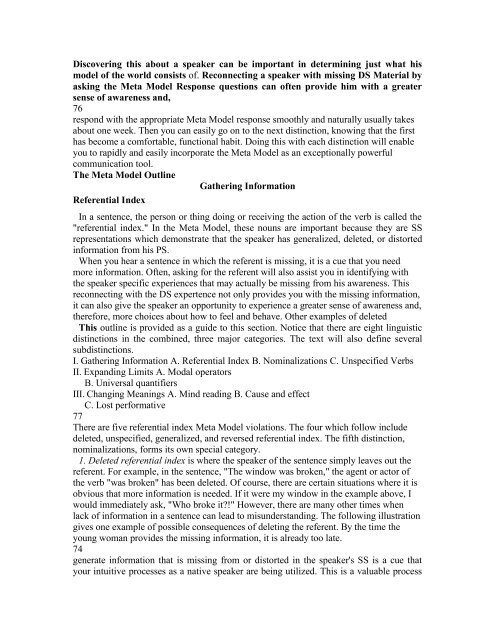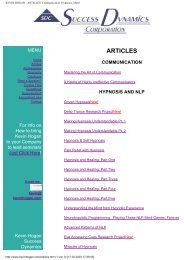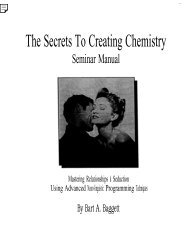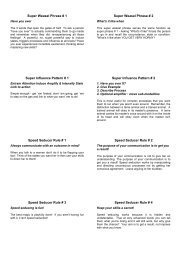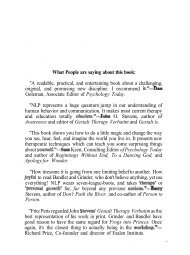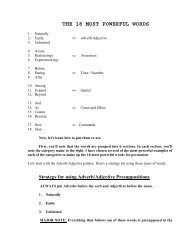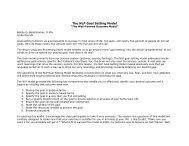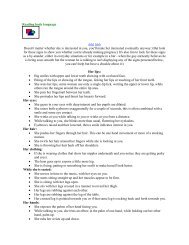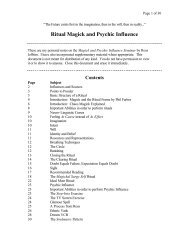A Pragmatic Guide To Communication & Change.pdf - NLP Info Centre
A Pragmatic Guide To Communication & Change.pdf - NLP Info Centre
A Pragmatic Guide To Communication & Change.pdf - NLP Info Centre
- No tags were found...
You also want an ePaper? Increase the reach of your titles
YUMPU automatically turns print PDFs into web optimized ePapers that Google loves.
Discovering this about a speaker can be important in determining just what his<br />
model of the world consists of. Reconnecting a speaker with missing DS Material by<br />
asking the Meta Model Response questions can often provide him with a greater<br />
sense of awareness and,<br />
76<br />
respond with the appropriate Meta Model response smoothly and naturally usually takes<br />
about one week. Then you can easily go on to the next distinction, knowing that the first<br />
has become a comfortable, functional habit. Doing this with each distinction will enable<br />
you to rapidly and easily incorporate the Meta Model as an exceptionally powerful<br />
communication tool.<br />
The Meta Model Outline<br />
Gathering <strong>Info</strong>rmation<br />
Referential Index<br />
In a sentence, the person or thing doing or receiving the action of the verb is called the<br />
"referential index." In the Meta Model, these nouns are important because they are SS<br />
representations which demonstrate that the speaker has generalized, deleted, or distorted<br />
information from his PS.<br />
When you hear a sentence in which the referent is missing, it is a cue that you need<br />
more information. Often, asking for the referent will also assist you in identifying with<br />
the speaker specific experiences that may actually be missing from his awareness. This<br />
reconnecting with the DS expertence not only provides you with the missing information,<br />
it can also give the speaker an opportunity to experience a greater sense of awareness and,<br />
therefore, more choices about how to feel and behave. Other examples of deleted<br />
This outline is provided as a guide to this section. Notice that there are eight linguistic<br />
distinctions in the combined, three major categories. The text will also define several<br />
subdistinctions.<br />
I. Gathering <strong>Info</strong>rmation A. Referential Index B. Nominalizations C. Unspecified Verbs<br />
II. Expanding Limits A. Modal operators<br />
B. Universal quantifiers<br />
III. Changing Meanings A. Mind reading B. Cause and effect<br />
C. Lost performative<br />
77<br />
There are five referential index Meta Model violations. The four which follow include<br />
deleted, unspecified, generalized, and reversed referential index. The fifth distinction,<br />
nominalizations, forms its own special category.<br />
1. Deleted referential index is where the speaker of the sentence simply leaves out the<br />
referent. For example, in the sentence, "The window was broken," the agent or actor of<br />
the verb "was broken" has been deleted. Of course, there are certain situations where it is<br />
obvious that more information is needed. If it were my window in the example above, I<br />
would immediately ask, "Who broke it?!" However, there are many other times when<br />
lack of information in a sentence can lead to misunderstanding. The following illustration<br />
gives one example of possible consequences of deleting the referent. By the time the<br />
young woman provides the missing information, it is already too late.<br />
74<br />
generate information that is missing from or distorted in the speaker's SS is a cue that<br />
your intuitive processes as a native speaker are being utilized. This is a valuable process


